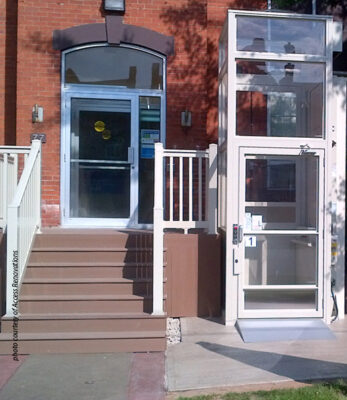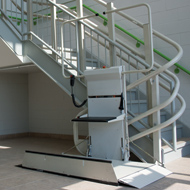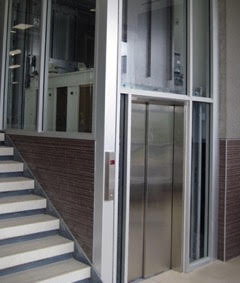Commercial Products
Commercial

Vertical Platform Lift (commonly referred to as a Wheelchair Lift)
- Primarily used as means of providing wheelchair access in and out of a private residence. Applications range from being used in a garage, exterior deck, front porch, or even as a through-the-floor elevator (when enclosed). – Rated at 600-750 lb. capacity.
- Platform lifts function with constant pressure on the controls, by the user.
- Variable lift heights up to 14 ft. If approved by the local authority having jurisdiction, some manufacturers offer lifts that will travel beyond 14 ft.
- Can be configured in a variety of ways such as installed adjacent to a deck inside a garage, or on a concrete pad in an exterior application, in front of an entry door, or offset.
- Most residential applications where the lift travel is 60 inches or less does not require an enclosure, per national code. Each municipality or state will have their own specific guidelines.
- Lifts are available for indoor and outdoor applications.
- Factory options from the manufacturers include upper landing gates, platform gates, automatic gate operators, automatic folding ramps, custom color options and battery drive / battery back up.
- There are a range of platform sizes and configurations available to suit the space requirements of the project. (Straight through, enter/ exit same side, 90 degree platform options)
- Common drive systems include recirculating ball screw mechanical or roped hydraulic options. There are performance differences that should be considered based on the actual application where the lift will be used.
 – Also designed to move a wheelchair in a home application, but instead of traveling vertically, the lifts will move up a staircase. The supporting guide rail system that the lift moves on can be mounted to a reinforced wall or the treads of the staircase.
– Also designed to move a wheelchair in a home application, but instead of traveling vertically, the lifts will move up a staircase. The supporting guide rail system that the lift moves on can be mounted to a reinforced wall or the treads of the staircase.
– Generally has a lower total capacity of 500 lbs., although some models can carry up to 600 lbs.
– Power requirements vary by manufacturer and model. Battery back up system is usually available as a factory option.
– Some basic models just have folding guard ramps on the platform, while other manufacturers offer manual or automatic folding safety barrier arms to help keep the user on the platform. Some models will also be able to have the platform fold up next to the wall when not in use.
– Functions with constant pressure controls on the platform and from each landing with remote controls.
– Can be designed for straight staircases as well as curved or spiral staircases.
– Incline lifts will generally require a wider staircase, which is not always possible in a residential application. Also requires almost 60 inches of landing space at the lower level, in front of the bottom stair riser, for the platform to land on the floor.
– Can be more expensive than a vertical platform lift due to the extremely customized design and niche type of product used when no other solution is possible.
 Stairway Lifts
Stairway Lifts
- While not being a product that satisfies ADA requirements, stairway lifts may be used in some suitable applications that do not require moving a person in a wheelchair. If local code authority will allow it, buildings such as churches, private organization buildings like Masonic Lodges, medical offices etc. may determine a stairway lift will meet their requirements.
- The stairway lifts have a chair that rides on a rail that is mounted to the staircase. The supporting guide rail system that the lift moves on can be mounted directly to the treads of a staircase.
- Generally has a lower total capacity of 300-400 lbs., although some models can carry up to 600 lbs.
– Power requirement is generally 120 VAC, and the lifts utilize a DC battery operation system to drive the lift up and down the staircase.
– Can be designed for straight staircases as well as curved or spiral staircases.
– Consideration needs to be given to the width of the staircase and any egress requirement enforced by the local code authority.
 Dumbwaiter
Dumbwaiter
- Utilized in establishments like restaurants, retail spaces, and in some lighter duty institutional use like schools, medical facilities or assisted living facilities.
- Varying capacities depending on the manufacturer and the specific application requirements.
- Automatic operation functions with call & send controls at each landing.
- Can serve multiple landings.
- Generally, is required to be enclosed in a constructed shaft with smaller size cabinet style doors at the landings. Some institutional models have larger doors and cab sizes to transport larger items and heavier loads.
- Lifts are usually only for indoor applications.
- There are a range of car sizes and configurations available to suit the space requirements of the project. (Straight through, enter/ exit same side, 90 degree platform options)
- Common options included for the interior of the dumbwaiter car are shelves, car light, stainless steel material
- Dumbwaiters are not recommended to use for commercial material handling applications. The limitations are generally due to the design and duty cycle ratings on dumbwaiters are not the same as commercial material handling equipment.
 Limited Use Limited Access Elevator (industry term is LULA)
Limited Use Limited Access Elevator (industry term is LULA)
- Also commonly used to address ADA compliance issues for commercial buildings such as schools, offices, municipal buildings and retail establishments.
- Capable of travel to 25 ft. and rated to a 1400 lb capacity. 18 sq ft cab sizes.
- Always utilizes an enclosed constructed shaft with automatic sliding doors at the landings. Very similar operation to a commercial elevator, except smaller in size and travels at a slower speed.
- There are a range of platform sizes and configurations available to suit the space requirements of the project. (Straight through, enter/ exit same side, 90 degree platform options)
- Drive system is roped hydraulic options.
- Requires a 14 inch pit in the bottom floor
- Capable of serving up to five landings within the 25 ft maximum travel. (if approved by the local code authority)
- Painted doors or stainless steel options, along with similar cab interior finish options from the manufacturer.
 Automatic Door Operators / Gate Operators
Automatic Door Operators / Gate Operators
- In applications where lifts are used that are required to meet ADA requirements or any local code requirements, the doors at each landing may need to open and close automatically to accommodate the user of the lift.
- Some operators are integrated into the header of the doorframe assembly (normally purchased that way from the door manufacturer) while others may be surfaced mounted and attached to the door.
- Operators are available to open and close wood doors, steel doors or gates on vertical platform lifts.
- The operators are controlled by the vertical lift itself, and will not open or close a door or gate unless the lift is at the landing.
- Operators can be installed independently of a lift, just opening and closing an entry door to a building.

